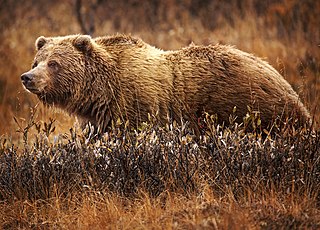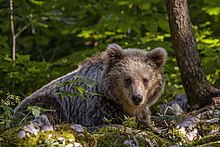
The brown bear is a large bear species found across Eurasia and North America. It is one of the largest living terrestrial members of the order Carnivora, rivaled in size only by its closest relative, the polar bear, which is much less variable in size and slightly bigger on average. Adults of different subspecies range in weight from 80 to 600 kg, with males being heavier than females. Despite its name, brown bears aren't entirely brown; the pelage can be reddish to yellowish-brown, and dark brown to cream in color. During winter, brown bears in some populations hibernate and emerge during spring to regain up to 180 kg (400 lb) of weight. They have well developed dentition and claws, ideal for their lifestyle.

The cave bear is a prehistoric species of bear that lived in Europe and Asia during the Pleistocene and became extinct about 24,000 years ago during the Last Glacial Maximum.

The Eurasian lynx is one of the four extant species within the medium-sized wild cat genus Lynx. It is widely distributed from Northern, Central and Eastern Europe to Central Asia and Siberia, the Tibetan Plateau and the Himalayas. It inhabits temperate and boreal forests up to an elevation of 5,500 m (18,000 ft). Despite its wide distribution, it is threatened by habitat loss and fragmentation, poaching and depletion of prey.

Ursus is a genus in the family Ursidae (bears) that includes the widely distributed brown bear, the polar bear, the American black bear, and the Asian black bear. The name is derived from the Latin ursus, meaning bear.

The California grizzly bear is an extinct population of the brown bear, generally known as the grizzly bear. "Grizzly" could have meant "grizzled" – that is, with golden and grey tips of the hair – or "fear-inspiring". Nonetheless, after careful study, naturalist George Ord formally classified it in 1815 – not for its hair, but for its character – as Ursus horribilis. Genetically, North American brown bears are closely related; in size and coloring, the California grizzly bear was much like the Kodiak bear of the southern coast of Alaska. The grizzly became a symbol of the Bear Flag Republic, a moniker that was attached to the short-lived attempt by a group of U.S. settlers to break away from Mexico in 1846. Later, this rebel flag became the basis for the state flag of California, and then California was known as the "Bear State".

The Atlas bear or North African bear was a population of brown bear native to North Africa that became extinct in historical times.

The Syrian brown bear is a medium and endangered subspecies of Eurasian brown bear native to the Middle East and West-Central Asia, particularly around the Caucasus Mountains.

The Himalayan brown bear, also known as the Himalayan red bear or isabelline bear, is a subspecies of the brown bear occurring in the western Himalayas. It is the largest mammal in the region, males reaching up to 2.2 m long, while females are a little smaller. It is omnivorous and hibernates in dens during the winter.

The Gobi bear, known in Mongolian as the Mazaalai (Мазаалай), is a subspecies of the brown bear that is found in the Gobi Desert of Mongolia. It is listed as critically endangered by the Mongolian Redbook of Endangered Species and by IUCN standards. Currently, there are only 31 bears left in the Mongolian Gobi Desert; through long-term genetic monitoring it is known that the population is relatively stable, however, the sex ratio is highly skewed towards males. Gobi bears are separated by enough distance from other brown bear populations to achieve reproductive isolation. In 1959, hunting of the animal was prohibited in order to preserve the dying subspecies.

The Marsican brown bear, also known as the Apennine brown bear, and orso bruno marsicano in Italian, is a critically endangered population of the Eurasian brown bear, with a range restricted to the Parco Nazionale d'Abruzzo, Lazio e Molise, and the surrounding region in Italy. The Marsican brown bear differs slightly from other brown bears in its appearance and hibernation techniques. The bear's popular name is derived from Marsica, a historic area of the modern-day region of Abruzzo where the bear has long had a significant presence.

The Mexican grizzly bear is an extinct population of the grizzly bear in Mexico.

Bear hunting is the act of hunting bears. Bear have been hunted since prehistoric times for their meat and fur. In addition to being a source of food, in modern times they have been favored by big game hunters due to their size and ferocity. Bear hunting has a vast history throughout Europe and North America, and hunting practices have varied based on location and type of bear.

The Cantabrian brown bear, Iberian brown bear, or Iberian bear is a population of Eurasian brown bears living in the Cantabrian Mountains of Spain.

The Ussuri brown bear, also known as the Ezo brown bear, Russian grizzly bear, or the black grizzly bear, is a subspecies of the brown bear or a population of the Eurasian brown bear. One of the largest brown bears, a very large Ussuri brown bear may approach the Kodiak bear in size. It is not to be confused with the North American grizzly bear.

Ursus deningeri is an extinct species of bear, endemic to Eurasia during the Pleistocene for approximately 1.7 million years, from 1.8 to 0.1 million years ago.

Ursus etruscus is an extinct species of bear, endemic to Europe, Asia and North Africa during the Pliocene through Pleistocene, living from ~5.3 million to 100,000 years ago.

The grizzly bear, also known as the North American brown bear or simply grizzly, is a population or subspecies of the brown bear inhabiting North America.
Formerly or currently considered subspecies or populations of brown bears have been listed as follows:

The brown bear is one of the most omnivorous animals in the world and has been recorded to consume the greatest variety of foods of any bear. Throughout life, this species is regularly curious about the potential of eating virtually any organism or object that they encounter. Certainly no other animal in their given ecosystems, short perhaps of other bear species and humans, can claim to feed on as broad a range of dietary opportunities. Food that is both abundant and easily obtained is preferred. Their jaw structure has evolved to fit their dietary habits. Their diet varies enormously throughout their differing areas based on opportunity. In spring, winter-provided carrion, grasses, shoots, sedges and forbs are the dietary mainstays for brown bears from almost every part of their distribution. Fruits, including berries, become increasingly important during summer and early autumn. Roots and bulbs become critical in autumn for some inland bear populations if fruit crops are poor. The dietary variability is illustrated in the western United States, as meat made up 51% of the average year-around diet for grizzly bears from Yellowstone National Park, while it made up only 11% of the year-around diet for grizzlies from Glacier National Park a few hundred miles to the north.

Brown bears were once native to Europe, much of Asia, the Atlas Mountains of Africa, and North America, but are now extirpated in some areas, and their populations have greatly decreased in other areas. There are approximately 200,000 brown bears left in the world. The largest population is in Russia, with 120,000 individuals. The brown bear occupies the largest range of habitats of any Ursus species with recorded observations in every temperate northern forest and at elevations as high as 5,000 m.

























